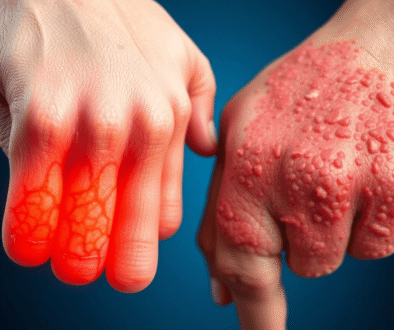Signs of Dehydration: What to Watch For and When to Worry
Most of us barely think about dehydration until it slows us down. It creeps up, draining our focus and strength before we even notice. Mild dehydration can hide in plain sight, showing only small, quiet changes.
Missing these signs can leave us at risk. Our bodies need water for every task: thinking, moving, and even resting. Catching problems early means staying sharp and healthy—not just for ourselves but for our families and friends too.
Watching for the first clues—dry lips, dark urine, or feeling lightheaded—matters more than most of us realize. By learning the early signals, we guard our energy and comfort every single day.
What Happens During Dehydration?
Our bodies run on water. When we don’t get enough, everything slows or breaks down. Dehydration is not just about feeling thirsty; it’s a chain reaction. As water levels dip, both small and large systems in the body begin to struggle.
Fluid Loss: The First Tipping Point
The moment we lose more water than we take in, problems begin. Everyday things like sweating, breathing, and even peeing use up water. We lose fluids faster in hot weather, during hard work, or when we’re sick. At first, the signs are quiet: our mouths get dry, skin feels chalky, and urine turns dark. Thirst tries to catch our attention, but many of us miss it until later.
What Happens Inside the Body?
When we’re low on fluids, our bodies make quick changes to save what little water is left. Blood gets thicker. This is the body’s way of keeping blood pressure stable, but it also makes the heart work harder. As a result, blood moves less smoothly to muscles and organs. Even the brain feels this slowdown. We might notice foggy thinking, trouble focusing, or trouble making simple choices.
The longer dehydration lasts, the worse it gets. Sweat can stop. Our skin may not bounce back when pinched. Urine becomes very dark, and there may be less of it. We might feel dizzy, tired, or sick to our stomach.
 Photo by Kaboompics.com
Photo by Kaboompics.com
Electrolyte Imbalance: The Hidden Danger
Water loss doesn’t just remove fluid. We also lose salts: sodium, potassium, calcium, and magnesium. These minerals, or electrolytes, run the “wiring” of our nerves and muscles. When they’re gone, nerves misfire, and muscles can cramp or weaken. In severe cases, our heart rhythm can become unsafe. This is why severe dehydration often leads to confusion, a racing heart, or even fainting.
Who’s Most at Risk?
Some of us are more likely to slip into dehydration:
- Kids and babies—they lose water faster than adults.
- Older adults—our thirst signal fades as we age.
- People with chronic illness—especially those with diabetes or kidney problems.
- Those on medications like diuretics, which pull water from the body.
People who can’t safely get water when they need it—because of illness, frailty, or extreme heat—need the most help and careful watch.
What Does the Body Do to Compensate?
To fight back against dehydration, our body turns on its emergency settings:
- Less urine: Kidneys try to save water.
- Less sweat: Skin stays dry, but body heat rises.
- Higher heart rate: The heart works harder to move thickened blood.
- Quick, shallow breathing: The body tries to keep tissues supplied with what little fluid is left.
When dehydration reaches a critical point, normal signs slip into emergency: confusion, low blood pressure, fast heartbeat, and sometimes loss of consciousness. At this stage, getting fluids quickly is essential to prevent long-term harm or worse.
Dehydration is simple in cause, but the results can be harsh and move fast. By spotting early signs, we stay one step ahead and keep our bodies working at their best.
Common Physical Signs to Watch For
Dehydration doesn’t wait for a convenient moment to strike. Sometimes, all it takes is a skipped water break or a hot afternoon. The first warning signs often show up in small, surprising places on and in our bodies. Noticing these early changes often helps us fix the problem before it grows serious. Here are some of the most common physical signals our bodies send when they need more water.
Changes in Urine and Bathroom Habits
Our urine tells a clearer story about hydration than most of us realize. We should pay close attention because the color, smell, and amount can change quickly with dehydration.
- Darker urine: Healthy, hydrated urine is pale yellow or nearly clear. When water is short, urine becomes dark yellow, amber, or even brownish. That’s the body hanging on to every drop of fluid it can.
- Reduced frequency: If we’re only urinating a couple of times a day (or not at all for hours), it’s time to worry. The kidneys slow things down, trying to keep water inside the body.
- Strong odor: Dehydration makes the wastes in urine more concentrated, causing a potent or strong smell.
Tracking these changes gives us one of the easiest, most honest ways to judge if we need to drink up.

Photo by Anna Tarazevich
Feelings of Weakness, Fatigue, and Dizziness
Sometimes, dehydration creeps in and feels like just a rough day—until standing up makes the room spin. Low water levels reduce blood volume and slow blood to the brain and muscles.
Some red flags we might notice:
- Weakness and fatigue: Muscles tire faster, and we feel drained even with little activity.
- Dizziness or lightheadedness: Especially when standing up or moving quickly, we may feel faint because the body can’t maintain normal blood pressure.
- Brain fog: Trouble focusing, slower thinking, or struggling with simple decisions are classic signs the brain isn’t getting enough fluid flow.
These symptoms can feel like stress or lack of sleep but usually ease soon after a good, slow rehydration.
Dry Mouth, Skin, and Eyes
If our mouths feel parched or our eyes itch for no clear reason, dehydration might be the culprit. Water keeps many surfaces in the body moist and flexible.
Noticeable changes include:
- Dry mouth and cracked lips: Saliva dries up without enough water, making the mouth sticky and uncomfortable.
- Chalky tongue and rough lips: The tongue may feel like sandpaper, and lips begin to split or peel.
- Dry, itchy eyes: Tears evaporate faster, so blinking may sting or feel gritty.
- Loss of skin elasticity: Pinch the skin on the back of your hand—if it doesn’t bounce back right away, dehydration has set in.
These clues might seem small, but they matter. They’re signals that our body needs more water to keep basic systems running well. Catching them early helps us feel bright and ready, even on busy days.
Serious Warning Signs That Need Fast Action
We all know feeling thirsty means we need water, but some signs of dehydration call for urgent care. Not all symptoms are alike, especially in children and older adults. Some may slip by unnoticed—yet missing them can put lives in danger. Here’s how to spot the red flags that mean it’s time to stop what we’re doing and get help.
Symptoms Unique to Children and Older Adults
Infants, kids, and older adults show trouble signs that aren’t always obvious. While the rest of us might just feel tired or thirsty, their bodies signal distress in quieter, specific ways.
In children, look out for:
- No tears when crying: Babies and young children often cry with no tears if they’re very dehydrated.
- Fewer wet diapers: Fewer than six wet diapers per day, or none for over eight hours, is a red flag.
- Sunken soft spot: The soft area on a baby’s head (called the fontanelle) may look sunken.
- Dry mouth and tongue: Sticky, dry gums or white patches in the mouth.
- Sunken eyes: Eyes lose their shine and appear hollow.
- Crankiness or fussiness: Kids may be harder to comfort or unusually irritable.
- Lethargy: Some children become hard to wake up or show little energy.
Older adults show danger signs too, but sometimes these get mistaken for other problems, like memory lapses or tiredness:
- Confusion: Sudden trouble thinking, trouble speaking clearly, or acting strange.
- Drowsiness or sudden sleepiness: Unusual fatigue, wanting to sleep most of the day, or trouble staying awake.
- Low urine output: Very little urine, or dark, concentrated urine.
- Dizziness: They may feel faint, stagger, or appear to wobble when walking.
- Cool, dry skin: Skin may feel dry or cold, with poor bounce-back when gently pinched.
Pay close attention, as these symptoms show that the body is struggling to keep enough fluid to function. If we see these signs in our kids or older family, quick action can make all the difference.

Photo by Louis Bauer
When Dehydration Becomes Life-Threatening
Sometimes dehydration moves way past discomfort. Life can shift in minutes from mild warning signs to full-blown emergencies that can’t wait.
Watch for these dangerous symptoms:
- Shock: Look for pale, cold, and clammy skin. The pulse races but feels weak. Blood pressure may drop so low a person can’t sit up.
- Severe confusion or unconsciousness: If someone can’t answer simple questions, becomes unresponsive, or slips into unconsciousness, it’s a 911 moment.
- Collapse or fainting: Sudden falls without warning, even if only for a few seconds, point to a severe problem.
- Seizures: Moments of shaking, jerking movements, or tensing of the body signal a medical emergency. Electrolyte loss sometimes sets this off.
- Very rapid or shallow breathing: Gasping or breathing much faster than normal.
What sends dehydration to this emergency stage? Usually, the body’s fluid and salt levels have dropped so low that organs can’t work right. Blood may no longer reach the brain and muscles. The heart strains to keep up, but eventually, it can’t keep the blood pressure high enough. Left untreated, this can cause long-term health problems or even death.
Whenever we see these warning signs in anyone—child, adult, or elder—call for medical help right away. Seconds count. Quick fluids, proper care, and trained hands can save a life when dehydration strikes hard.
What to Do If You Spot Signs of Dehydration
Spotting the first warning signs of dehydration gives us the upper hand. Whether it’s feeling dizzy, noticing dry skin, or seeing dark urine, quick action can stop things from getting worse. We can treat mild cases at home, but sometimes a doctor’s help is needed. Below are clear steps to follow when dehydration starts showing its hand.
Start Rehydrating Right Away
If we notice signs like a dry mouth, headache, or dark urine, it’s time to act. Drinking water is the fastest and safest way to begin recovery. For most of us, plain water does the trick. But if someone has lost a lot of fluid from sweating or illness, oral rehydration solutions (like those with electrolytes) work better to replace both salts and fluids.
Here are simple tips for getting fluids back into the body:
- Sip water often, even if not feeling thirsty.
- Choose oral rehydration solutions if there’s vomiting, diarrhea, or lots of sweating.
- Eat water-rich foods like oranges, watermelon, and cucumbers.
- Avoid caffeine and alcohol since they pull more water out of our bodies.
If someone feels sick and can’t keep fluids down, ice chips or small sips can help. Start slow and build up as the stomach settles.
Rest and Take It Easy
Dehydration saps our strength. It’s important to pause and let the body catch up.
- Rest in a cool, shaded spot or inside where it’s air-conditioned.
- Loosen tight clothing so the skin can breathe and sweat evaporates.
- Lay down if dizzy or lightheaded to avoid falls or injury.
The more we rest, the easier it is for our bodies to re-balance and recover.
Keep an Eye on Symptoms
Some signs fade fast with rehydration, but others can linger or get worse. Keep watch for any changes in yourself or someone else.
Track these key points:
- Are lips, mouth, and skin less dry after drinking?
- Does urine lighten up or flow more often?
- Do symptoms like headache or fatigue improve?
- Is thirst gone, or still there after fluids?
If things get better after drinking and resting, that’s good. But if symptoms return or new ones show up, we may need more help.
Know When to Seek Medical Help
Mild dehydration heals with fluids and rest. But some warning signs can’t wait. Call a doctor or go to the nearest clinic if you notice:
- Very little or no urination for eight hours or longer
- Extreme thirst that fluids can’t quench
- Rapid heartbeat, fainting, or confusion
- Ongoing vomiting or diarrhea that stops fluids from staying down
- Sunken eyes, fast breathing, or drowsiness in a child or frail adult
Severe cases need hospital care, often with intravenous fluids. If someone loses consciousness or has a seizure, call emergency services right away.

Photo by Tima Miroshnichenko
Prevent Things From Getting Worse
While helping ourselves or someone else, prevention can stop the problem from returning. Here’s how we can help our bodies stay hydrated:
- Drink small amounts all day, not just at meals.
- Stay out of hot sun and humid areas when possible.
- Use fans or air conditioning in hot weather.
- Take breaks during physical activity and drink water before, during, and after.
- Keep rehydration drinks or snacks handy on busy days or when sick.
Taking small, steady steps helps stop a small problem from growing. Reacting fast, resting, and watching for warning signs give us a better shot at fast recovery every time we spot dehydration’s early clues.
Conclusion
Staying alert to signs of dehydration keeps us steady and safe. Even mild warning signs—like dark urine or dry skin—matter. Simple steps, such as sipping water and watching for changes, bring quick results and help prevent bigger problems later.
Each of us can play a part by checking in on loved ones and sharing what we’ve learned. If you have tips that work or stories to share, post a comment below. The more we share, the easier it is for everyone to stay well.
Thank you for reading and caring about your health and others. Small habits today help us all feel our best tomorrow.


